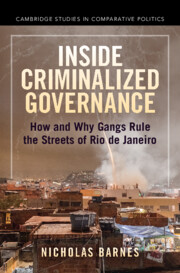Book contents
- Inside Criminalized Governance
- Cambridge Studies in Comparative Politics
- Inside Criminalized Governance
- Copyright page
- Dedication
- Contents
- Figures
- Tables
- Acknowledgments
- A Note on Translation
- Abbreviations, Acronyms, and Translated Words
- 1 Introduction
- 2 Criminalized Governance
- 3 A Theory of Criminalized Governance
- 4 The Origins of Criminalized Governance
- 5 Comando Vermelho of Nova Holanda
- 6 Comando Vermelho of Parque União
- 7 Terceiro Comando (Puro) of Complexo da Maré
- 8 Criminalized Governance during Military Occupation
- 9 Conclusion
- 10 Epilogue
- Appendices
- References
- Index
- Other Books in the Series (continued from page ii)
8 - Criminalized Governance during Military Occupation
Published online by Cambridge University Press: 06 February 2025
- Inside Criminalized Governance
- Cambridge Studies in Comparative Politics
- Inside Criminalized Governance
- Copyright page
- Dedication
- Contents
- Figures
- Tables
- Acknowledgments
- A Note on Translation
- Abbreviations, Acronyms, and Translated Words
- 1 Introduction
- 2 Criminalized Governance
- 3 A Theory of Criminalized Governance
- 4 The Origins of Criminalized Governance
- 5 Comando Vermelho of Nova Holanda
- 6 Comando Vermelho of Parque União
- 7 Terceiro Comando (Puro) of Complexo da Maré
- 8 Criminalized Governance during Military Occupation
- 9 Conclusion
- 10 Epilogue
- Appendices
- References
- Index
- Other Books in the Series (continued from page ii)
Summary
In April 2014, two months before the start of the World Cup, 2,500 Brazilian Army and Marine soldiers occupied Complexo da Maré. They would stay there for the next fifteen months. The occupation of Maré was the culmination of Rio’s once-heralded Police Pacification Units, a public security program intended to recapture the state’s monopoly of violence from drug-trafficking gangs in hundreds of favelas throughout the city. This chapter begins by tracing the confluence of factors which led to the Brazilian military’s intervention. A mix of participant observations, interviews, and newspaper accounts then document the military’s arrival and their various operations and activities to combat gangs and gain the support of the local population. The chapter proceeds to analyze how and why each of Maré’s gangs responded differently to the challenges of occupation, arguing that the military lacked the capacity to fully expel or dismantle them though their presence shifted the dynamics of rival competition and threat, which produced the divergent gang responses observed.
Keywords
- Type
- Chapter
- Information
- Inside Criminalized GovernanceHow and Why Gangs Rule the Streets of Rio de Janeiro, pp. 243 - 270Publisher: Cambridge University PressPrint publication year: 2025

